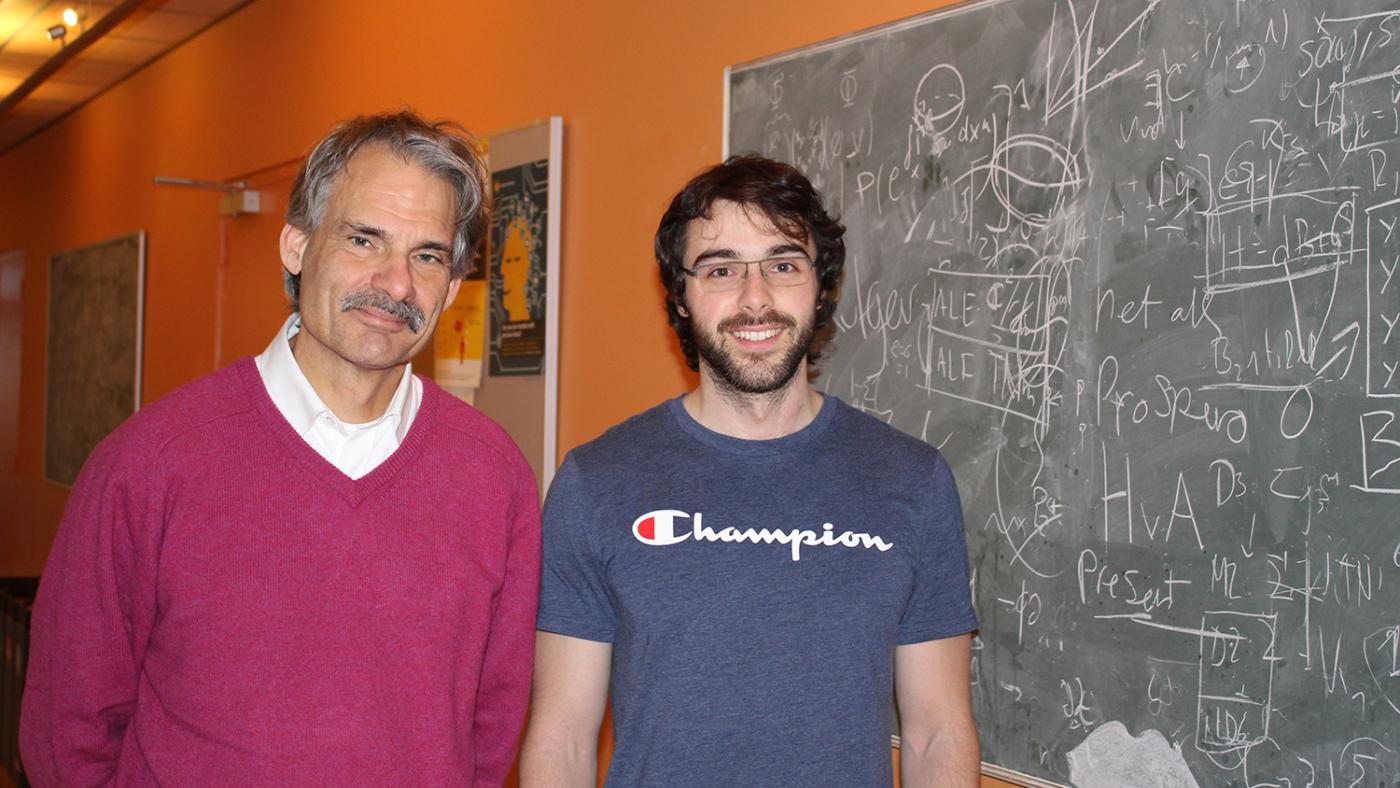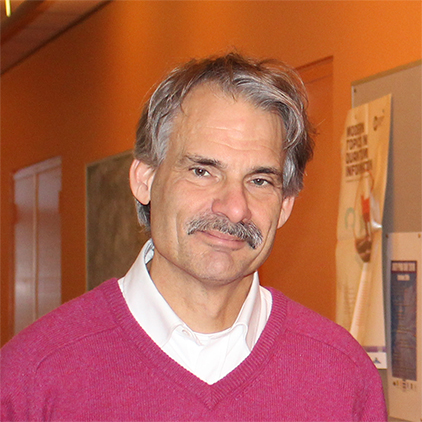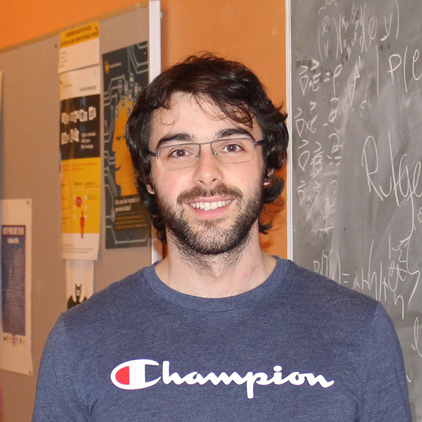Old dog to young blood: ‘A good scientist should also be good at networking’

‘Still waters run deep,’ says Henk Stoof, professor of condensed matter physics, about his Italian protégé Enea Mauri. Stoof: “Enea seems like the quiet type, but he’s one of the best PhD candidates I’ve ever supervised.” Mauri graduated under Stoof’s supervision on a study on high temperature superconductors, which won him the Shell Graduation Award for Physics. To Stoof’s delight, Mauri decided to continue his research with Stoof as a PhD candidate.
Holy Grail
‘Young blood’ Mauri (26) and ‘old dog’ Stoof (56) aren’t the only scientists fascinated with superconductors. On the contrary. All across the world, physicists have been focusing on the complex yet interesting phenomenon for more than a century.
In 1911, Dutch physicist Heike Kamerlingh Onnes discovered superconductors: materials in which, when cooled below a critical temperature, the electrical resistance disappears. This way, electricity has zero resistance. No heat is generated, so no energy is lost. A revolutionary discovery – but one that’s not without issues. The materials only superconduct when they’re cooled to extremely low temperatures. And that in itself requires energy.
Finding a superconductor at room temperature has been physicists’ holy grail ever since Kamerlingh Onnes’ discovery. Stoof: “A material that’s superconducting at room temperature would have an enormous impact on the world. It would largely solve the world’s energy crisis. Our lights, refrigerators, and computers would become much, much more energy efficient. All those wind energy parks would become redundant.”
Breakthrough next to impossible
We’re nowhere near that point right now. The highest temperature superconductivity can take place at right now, is -100 degrees Celsius. “To physicists, that’s already quite warm,” Stoof laughs. They don’t call these materials ‘high temperature superconductors’ for nothing. It’s those materials that Stoof and Mauri’s research focuses on. Mauri: “It’s still a mystery why these materials are superconductors. We try to unravel this mystery, hoping the answers will take us one step closer to superconductivity at room temperature.”
For years, Stoof and Mauri will work on a tiny piece of the enormous puzzle. How big is the chance these two theoretical physicists will force a breakthrough and be awarded the Nobel Prize? Mauri: “Ha ha, that is next to impossible. It would be amazing, but this is truly incredibly complicated, and will take decades of research.” Stoof: “There will probably eventually be one brilliant mind who makes the breakthrough discovery. But that will still be the result of the many small steps taken by scientists such as ourselves as well as many others.”
The Netherlands join forces
The worldwide competition between research groups that focus on high temperature superconductors is great. In order to compete with strong groups in the US, Dutch universities have now joined forces. Amsterdam, Leiden, Nijmegen, and Utrecht received a joint grant for research from research financier NWO.
Both theoretical and experimental groups are part of this collaboration. A good development, Stoof thinks: “By combining these strengths, we can move forward much faster.” The presence of the multitude of research groups on superconductivity was one of the reasons Mauri chose the Netherlands for his studies: “Now that these groups are collaborating as well, I’m reaping the benefits.”
What you do, but – especially – who you know
Mauri’s decision to move to Utrecht for his Master’s from his home town of Milan, turned out to be a good one. Right moment, right place. Stoof can’t help but be mildly jealous. He was forced to discard the subject he’d spent most of his career researching. “For years, I studied so-called ultra-cold atoms. Unfortunately, there aren’t many research groups in the Netherlands that work on this topic.” The consequence was that it became hard for Stoof to obtain research funds. “In order to obtain a research grant these days, you have to be working together with many other scientists, organised in a consortium. There’s hardly any individual financing.”
The physicist therefore turned his attention to subjects that were more popular amongst Dutch research groups. Stoof: “It hurts to quit something you’ve been working on for so many years. But it’s also a part of the volatility of science.”
Stoof says the fact that scientists are joining forces in large consortiums for the sake of research grants, is a development that can’t be stopped. It makes the lesson he wishes to teach Mauri all the more relevant: “Don’t underestimate the importance of networking. I always thought physics was about what you achieve, but in reality, it’s also incredibly important to know the right people, and to build rapport with them. That makes your life as a scientist a lot easier.” Mauri, who – as said – is the still-waters-run-deep quiet type, thinks about this and decides: “Yes, that’s definitely something I should work on.”
New insights from different points of view
Stoof isn’t the type to complain about his academic career path. He prefers to look ahead instead. He excitedly talks about the various studies he’s working on. Like the one by PhD candidate Erik van der Wurff. The PhD candidate, who was interviewed (in Dutch ed.) along with Stoof for this same interview series four years ago, then rejected two PhD positions abroad to do his PhD track with Stoof instead. It’s a gamble that paid off, because Van der Wurff is now nearing the end of his PhD track on topological materials.
These materials, which were discovered relatively recently, are an incredibly hot topic in the world of physics. Like superconductors, they can conduct energy without resistance, but they use an entirely different mechanism to do so. Stoof: “It’s inspiring to take the same theme, zero resistance electricity transportation, and look at it from different points of view. It can offer new insights – and with it, a lead.”
A mature physicist
Stoof had known at an early age that his future was in science. Will Mauri follow in his mentor’s footsteps? Mauri: “I don’t look ahead. I see interesting things happening in artificial intelligence, outside of science too. Perhaps I’ll go for that.” If that happens, Stoof will watch one of his most promising students leave science. A pity, Stoof thinks, but he won’t stand in his way. “A career in science is incredibly uncertain, and is basically a large chain of coincidences. Enea is already an enormously mature physicist at a young age. You don’t see that very often, so I hope we can keep him.”
Enea laughs uncomfortably at the praise. He thinks he’s a regular person. What’s made him such a mature physicist? After some pushing, he finally says: “Yeah, I may have spent some time during my studies reading a book that wasn’t part of the curriculum.” But, he says, that makes sense: “If you think a topic is interesting, don’t you want to read more about it?”
Intrinsic motivation
It’s that intrinsic motivation PhD candidates have that makes Stoof’s job of supervising them so valuable. PhDs like Mauri keep him on his toes. The office doors are always open, so the two often visit each other to discuss something, or ask the other one questions. Stoof: “It doesn’t happen often, ha ha, but when I’m wrong, Enea tells me that. He’s critical, as a good scientist ought to be. And thankfully, we can laugh with each other.”
Does their bond go beyond a shared love for the discipline? Stoof: “With Erik van der Wurff I shared a love of heavy metal music, but I think Enea likes cycling more.” Mauri: “Well, I’m not a very talkative person. It takes a while to build a personal connection with me. But I do like metal!” So who knows what’s in store for Stoof and Mauri.
 |  |
| Henk Stoof on Enea Mauri: “Enea is very strong in techniques. That means he works carefully, is critical of his own work, which means he doesn’t make mistakes in his calculations. That’s important for physicists. He does still need to learn how to communicate with experimentalists. Enea is a true theoretical physicist. He needs to learn to understand the language of the experimentalists. We’re working on that.” | Enea Mauri on Henk Stoof: “Henk has a talent not all professors have: his intuition in physics. It enables him to sometimes predict the outcome of calculations without actually doing the calculation. I greatly admire this. My only point of criticism would be that Henk should be a little more strict sometimes. I work better when I’ve got deadlines, so he should set them for me a little more often.” |